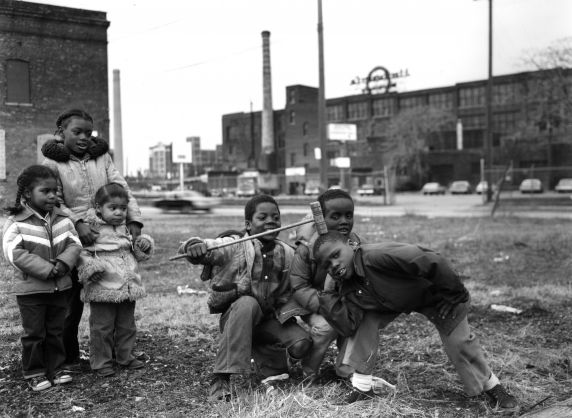Guest Post: Looking at Poletown
This post was authored by Justine Tobiasz, a student in the Wayne State University Archives Certificate Program, during the 2014-2015 academic year.
In 1981, a portion of the Detroit neighborhood known as Poletown was destroyed as a result of a deal between Mayor Coleman Young and General Motors to make room for a new Cadillac assembly plant. Using Michigan’s eminent domain law, Detroit officials obtained the titles of Poletown’s 1,400 homes, 144 businesses, and 16 churches which found themselves in the area north of 1-94 between Chene and Mount Elliott. The construction of the Edsel Ford Freeway (I-94 East) in the 1950s divided the community into north and south, and the proposed plant would demolish the northern section. The swift and massive relocation of citizens for the needs of private, corporate development was the largest in United States history. The June 1980 offer of the new GM assembly plant held its intention that 3,800 new jobs would be created in times of great economic recession. The ensuing events between 1980 and 1981 sharply divided residents in the proposed site--renamed the Central Industrial Park area--while other surrounding plants in the area, including Dodge Main, were shut down.
Polish immigrants had predominantly inhabited Poletown since the 1870s. For many generations, even until the economically depressed 1980s, it remained one of the most populated working class neighborhoods “known for its sound housing stock, its low rents, its good access to shops and services, and its tolerance for divergent ethnic groups and religious denominations. There were some black and white neighbors who had shared a block for fifty years, and a study done by the University of Michigan in 1980 suggested that the area may be one of the most continuously racially integrated areas in Michigan,” (Wylie, 1989). Despite sincere efforts in protest from various groups and attempts at legal action, the first buildings of north Poletown came down in the spring of 1981. The Reuther holds several collections with materials related to the General Motors Poletown project. Both the Kessler and Associates Records and Bruce L. Harkness Photograph Collection provide an in-depth inside understanding of the feelings and motives on both sides of the struggle.
In order for so many people and businesses to relocate on General Motor’s timeline, the city entered into a Memorandum of Agreement (MOA) with the Advisory Council on Historic Preservation in October of 1980. The Kessler and Associates Records contain materials such as photographs, documents, and maps related to the hiring of the architectural firm of William Kessler and Associates by the city of Detroit in order to determine if the project area held any landmarks of significant cultural or historical value and to make a record of their existence. Kessler’s Director of Historic Preservation Services, Michael Waho, had the job of determining whether anything in the survey would be a candidate for inclusion on the national register.
Bruce L. Harkness photographed the designated area from February to December of 1981, before and after the area of the Central Industrial Park was cleared. Taking over 400 photographs, he documented the neighborhood in all of its last glory: the landmarks and interiors and exteriors of homes and business, as well as the residents and daily street life. Though Harkness was one of many recording the changes taking place in the neighborhood, the images he produced tell a much more intimate portrait than seen elsewhere. Between the interiors and exteriors of buildings zoned for demolition, there are everyday shots of the people whose lives were significantly altered by the decisions made between the state of Michigan and General Motors. Women are seen hanging laundry and sweeping their porches, while children still play in the street. There are several images of men packing mattresses, chairs, and other belongings into moving trucks. The people shown are proud and defiant, always looking straight at the photographer. Harkness took detailed notes about each of his subjects and images and through them we are able to step back in time and see a neighborhood take its last breaths; his photographic records are an invaluable resource for scholars of not only Detroit’s history but also those looking to learn from past mistakes in urban planning and industrialization.
With funding from the Michigan Council of the Humanities and a Humanist Grant-in-Aid won by Wayne State University Professor of History John J. Bukowczyk, Harkness printed 200 of the photographs, in the form of 8”x10” silver gelatin, black and white prints. The Harkness Poletown Photographic Collection was donated to the WSU Folklore Archives’ Ethnic Archives Project.
References:
Wylie, J. (1989). Poletown: Community betrayed. Urbana: University of Illinois Press.
- Public Relations Team's blog
- Login to post comments
- Printer-friendly version


 Reddit
Reddit Facebook
Facebook LinkedIn
LinkedIn